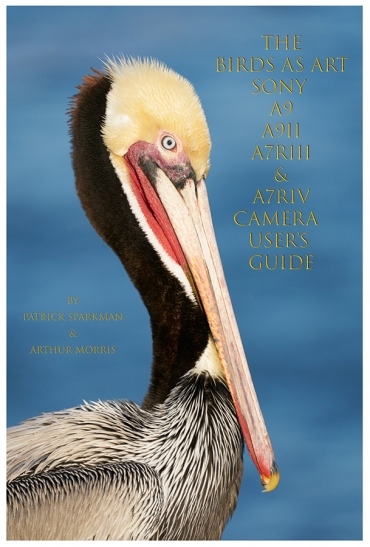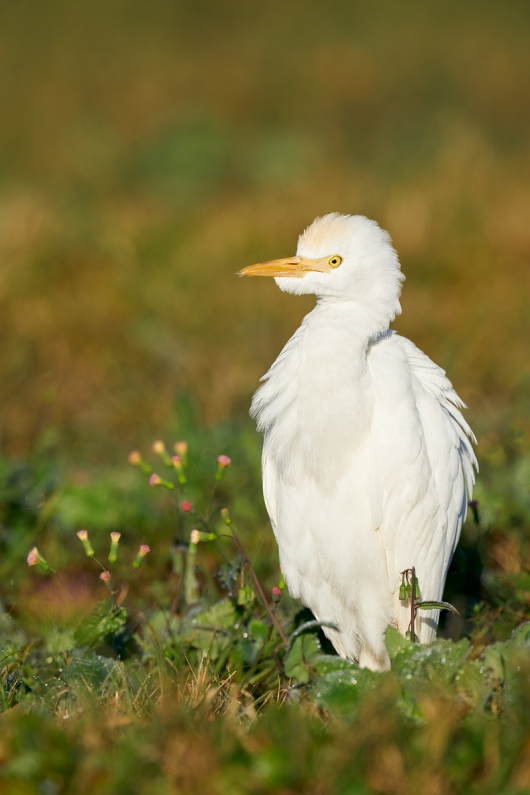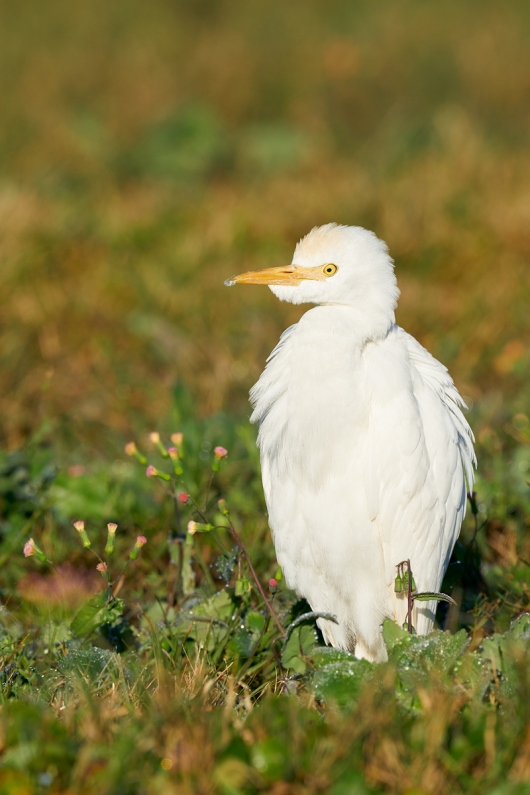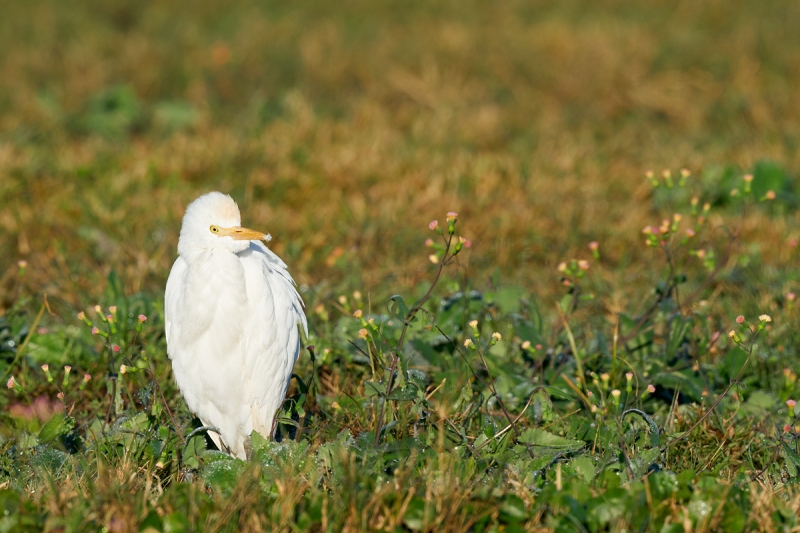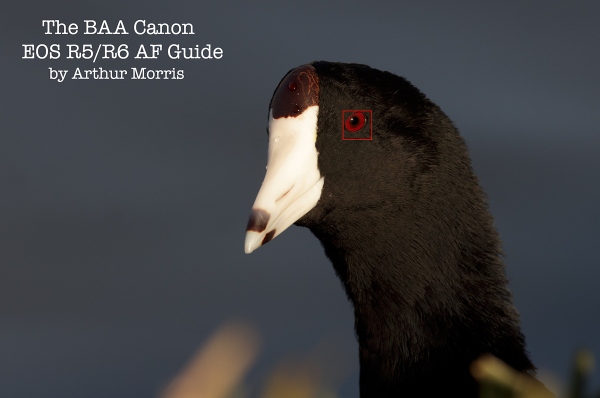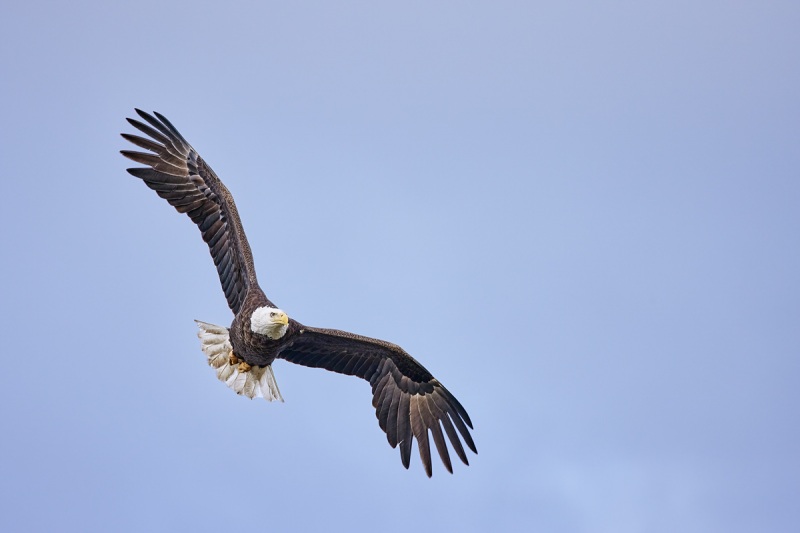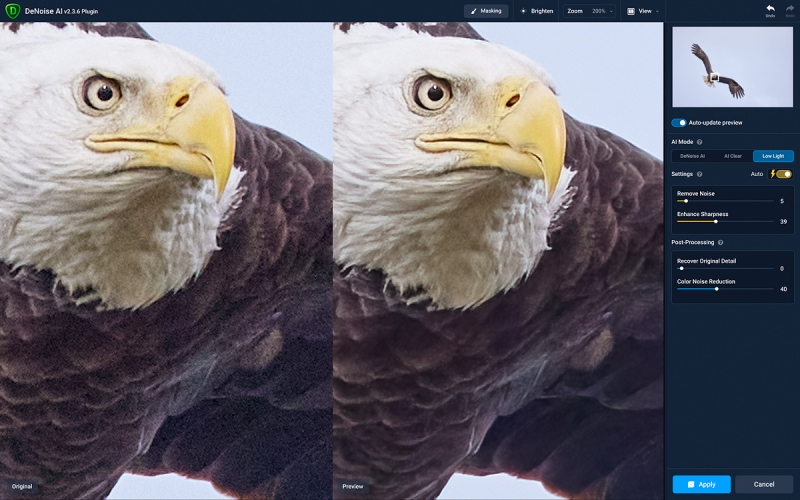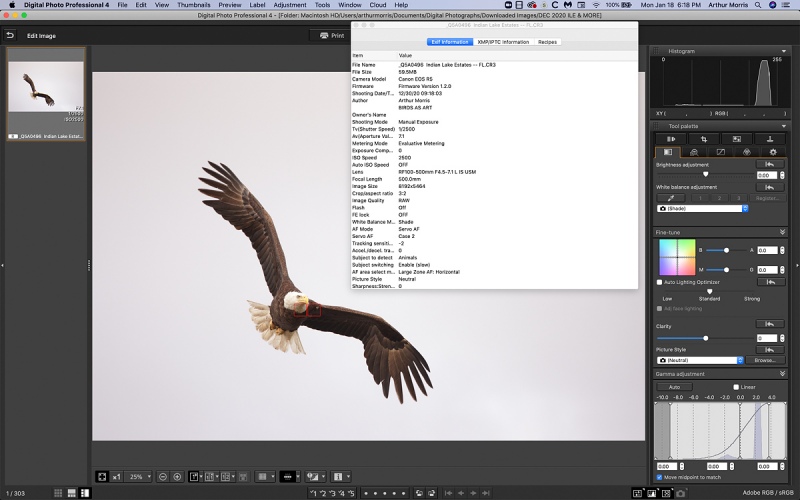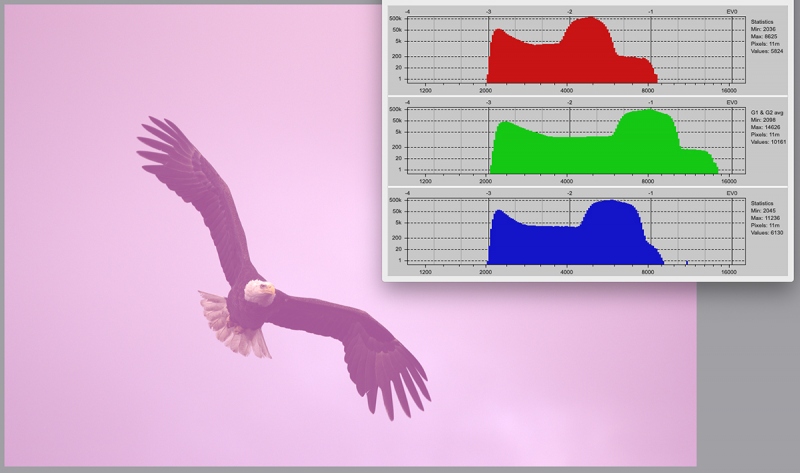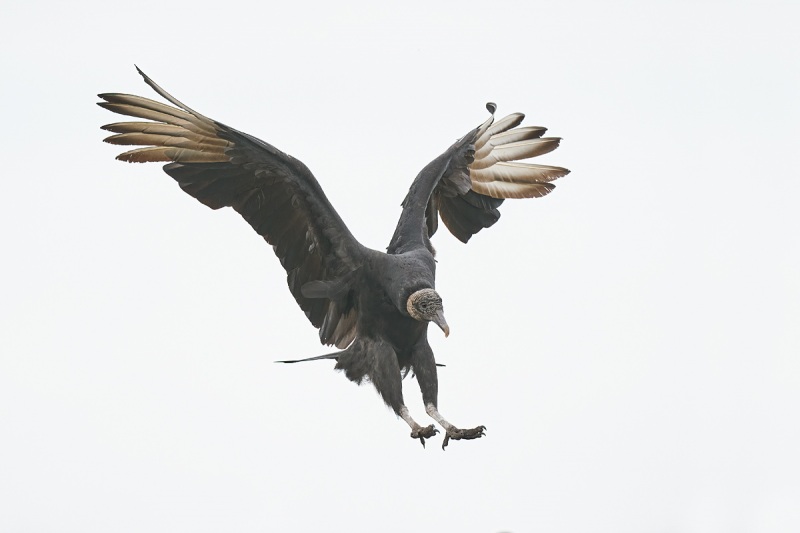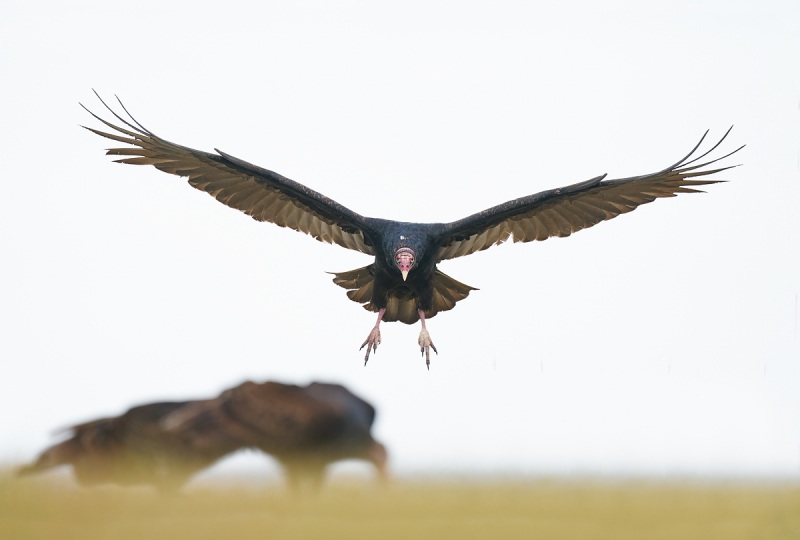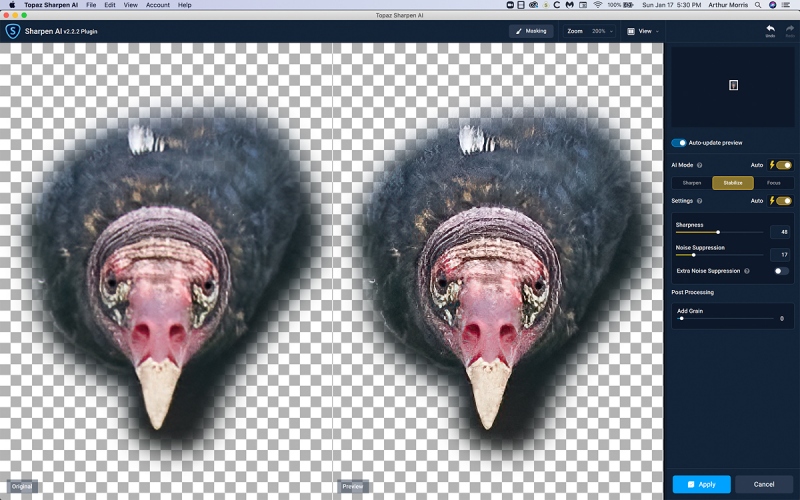What’s Up?
Yesterday morning turned out to be pretty good. In addition to a nice series of a very cooperative Cattle Egret posing in blooming tasselflowers, I go a few nice frames of a Red-Shouldered Hawk taking flight. As I was not quite ready (I should have been), the keepers are in need of some TLC with Topaz Sharpen AI …
I headed back down to the lake at 5:40pm, right before sunset and was very glad that I did. I had some light clouds on the western horizon and the wind was from the northeast. Since I was shooting silhouettes, the wind against sun conditions were perfect. I worked some single birds and small groups coming in just over the reeds. Just as the sun disappeared below the horizon, all hell broke lose: about 80 roosting birds took flight at once. Flushed by one of the local Bald Eagles the swirled around frantically in front of the still-richly-colored sky. Though I have not edited those images yet, I glanced at them and I did get a few very good frames. Some with the silhouetted eagle in the frame.
I just finished sending out the last pre-publication copy of the RawDigger e-Guide for review. If you purchased an advanced copy and did not receive the link, please let me know via e-mail.
I will be working on the Adapted Histogram video very soon. Today is Wednesday 20 January 2021. The forecast for this morning is for more clear skies with gentle winds from the north. I will be heading down to the lake early to see what I see.
Thanks to on-line friend and wildflower expert John Bradford for identifying today’s flowers.
This blog past makes thirty-one days in a row with a new blog post. This one took about 2 1/2 hours to prepare. Please remember …
Please Remember
With income from IPTs approaching zero, please, if you enjoy and learn from the blog, remember to use one of my two affiliate programs when purchasing new gear. Doing so just might make it possible for me to avoid having to try to get a job as a Walmart greeter and will not cost you a single penny more. And if you use Bedfords and remember to enter the BIRDSASART code at checkout, you will save 3% on every order and enjoy free second-day air shipping. In these crazy times — I am out at least forty to sixty thousand dollars so far due to COVID 19 (with lots more to come) — remembering to use my B&H link or to shop at Bedfords will help me out a ton and be greatly appreciated. Overseas folks who cannot order from the US because of import fees, duties, and taxes can always help out by clicking here if they see fit.
|
|
RawDigger e-Guide pre-publication version |
RawDigger e-Guide and Video Advance Copy Still Available — but not for long …
Save $10 Now
The RawDigger e-Guide and Video is almost finished. It will sell for $51.00. If you are anxious to get started with RawDigger, learn to mega-Expose to the Right, and wind up with the highest quality image files, you can save $10.00 and have a chance to review a recently updated pre-publication version of the guide by sending a PayPal for $41.00 to birdsasart@verizon.net with the words RawDigger e-Guide and Video Pre-publication Copy cut and pasted into the Subject line. The recent delay is the result of my recent conversations with Iliah Borg, the brains behind RawDigger. It is very likely that the Shock-your-World section will shock you.
In the new guide, we teach you why the GREEN channel is almost always the first to over-expose. We teach you how to interpret the Max G values. And most recently, we teach you a simple way to evaluate your exposures using an adapted RawDigger histogram. And tons more, of course. I am planning on having the completed RawDigger e-Guide ready for sale by this coming Wednesday. Folks who saved $10.00 by pre-ordering will of course receive a link to the final PDF.
The BAA Used Gear Page
The Used Gear page continues to be very active. The BAA Used Gear Page is the place to sell your used photographic equipment. We will help you to get your gear sold quickly for 20 to 60% or more than what the big guys are offering … Doubt me? Check out the Recent Sales list for the past eleven months at the bottom of the page.
Canon EF 300mm f/2.8L IS II USM Lens
Tom Mast is offering a Canon EF 300mm f2.8L IS II USM lens in like-new condition (used only three times in the past 2 years) for a very low $3399.00. The sale includes the original shipping box, the lens trunk, the front lens cover, the rear lens cap, and insured ground shipping via major courier to lower-48 US addresses only. Your item will not ship until your check clears unless other arrangements are made.
Please contact Tom via e-mail or by phone at 1-260-348-9004 (from 8am to 8pm Eastern time zone.
The 300mm f/2.8 autofocus lenses have long been the first choice of the world’s best hawks-in-flight photographers with and without a 1.4X TC. When teamed up with either the 1.4X or 2X TC, they make a great hand-holdable walk-around lens. For folks with an EOS R5, the 300 II would make a great workhorse lens for bird photography and an incredible flight lens Grabbing Tom’s lens will save you an incredible $2,700.00 as new ones are going for $6099.00 from B&H. I owned and used several versions of the 300 f/2.8 lens for many years until finally replacing my 300 f/2.8 II with the 400 DO II several years ago. That said, the 300 f/2.8 II represents a great value as the 400 DO II now sells new for $6,899.00. artie
|
|
|
134 sold to rave reviews. The SONY e-Guide by Patrick Sparkman and Arthur Morris |
The Sony Camera User’s e-Guide (and Videos)
Click here to purchase the guide with one Camera Set-up Video. Be sure to e-mail us by clicking here to specify your camera body so that we can send you a link for the correct video.
Click here to purchase the guide with two Camera Set-up Videos. Be sure to e-mail us by clicking here to specify your two camera bodies so that we can send you links for the correct videos.
Click here to learn more about the SONY e-Guide.
Folks who have used my B&H affiliate links or purchased their SONY gear are invited to e-mail for discount information.
New and Better Bedfords Discount Policy!
You can now save 3% on all of your Bedfords photo gear purchases by entering the BIRDSASART coupon code at checkout. Your discount will be applied to your pre-tax total. In addition, by using the code you will get 2nd day air shipping via Fed Ex.
Grab a Nikon AF-S Teleconverter TC-14E III and save $14.99. Purchase a Canon EOS R5 and your discount will be $116.97. Purchase a Sony FE 600mm f/4 GM OSS lens and save a remarkable $389.94! Your Bedford’s purchase no longer needs to be greater than $1,000.00 for you to receive a discount. The more you spend, the more you save.
Money Saving Reminder
Many have learned that if you need a hot photo item that is out of stock at B&H and would enjoy free overnight shipping, your best bet is to click here, place an order with Bedfords, and enter the coupon code BIRDSASART at checkout. If an item is out of stock, contact Steve Elkins via e-mail or on his cell phone at (479) 381-2592 (Central time). Be sure to mention the BIRDSASART coupon code and use it for your online order to save 3% and enjoy free 2nd-day air shipping. Steve has been great at getting folks the hot items that are out of stock at B&H and everywhere else. The wait lists at the big stores can be a year or longer for the hard to get items. Steve will surely get you your gear long before that. For the past year, he has been helping BAA Blog folks get their hands on items like the SONY a9 ii, the SONY 200-600 G OSS lens, the Canon EOS R5, the Canon RF 100-500mm lens, and the Nikon 500mm PF. Steve is personable, helpful, and eager to please.


Gear Questions and Advice
Too many folks attending BAA IPTs (remember those?) and dozens of photographers whom I see in the field and on BPN, are–out of ignorance–using the wrong gear especially when it comes to tripods and more especially, tripod heads… Please know that I am always glad to answer your gear questions via e-mail. Those questions might deal with systems, camera bodies, accessories, and/or lens choices and decisions.
|
|
|
This image was created on 18 January 2021 while working from my SUV in the North Field at Indian Lake Estates. I used the Induro GIT 204/Levered-Clamp FlexShooter Pro-mounted Sony FE 600mm f/4 GM OSS lens, Sony FE 1.4x teleconverter, and the blazingly fast AF King, the Sony Alpha a9 II Mirrorless Digital Camera Body. ISO 400: 1/2000 sec. at f/6.3 (stopped down 1/3 stop) in Manual mode. AWB at 9:34am on a sunny morning. Tracking Expand Flexible Spot AF-C was active at the moment of exposure and performed to perfection. Click the image to see the spectacular larger version. Image #1: Cattle Egret and tasselflower blossoms |
Stopping Down 1/3 Stop
In general, when working with long lenses, I will stop down 1/3 stop with or without a TC. With the 600 f/4 lenses alone, I will normally work at f/4.5. With the 1.4X TC (as here), I will usually work at f/6.3. And when working at 1200mm with the 2X, f/9 is my go-to aperture. I do that mostly out of habit; with the telephoto lenses of more than a decade older, stopping down a bit from wide open was advised to create slightly sharper images. Note that in identical situations, Patrick Sparkman works at the wide open aperture …
While it is proper technique to stop down one stop or more –even two stops on occasion — for additional depth-of-field when working at or near the minimum focusing distance of a lens, that is not necessary at all when working with relatively distant subjects like the Cattle Egret in all three of today’s featured images. In those cases the depth-of-field provided by the distance to the subject will be more than enough to cover the entire subject.
Note the relatively creamy texture of the background.
The Setting up a Tripod in your Vehicle Video
Learn how here. While using a BLUBB is a very convenient way to shoot from your car window, setting up a tripod in your vehicle is a huge pain in the butt. But lens handling is unparalleled if you take the time to do it right and with a FlexShooter head, you can easily shoot flight from the driver’s seat. On a related note, we are almost sold out of the Levered-clamp FlexShooter Pro heads.
|
|
|
This image was also created 18 January 2021 while working from my SUV in the North Field at Indian Lake Estates. I used the Induro GIT 204/Levered-Clamp FlexShooter Pro-mounted Sony FE 600mm f/4 GM OSS lens, Sony FE 1.4x teleconverter, and the blazingly fast AF King, the Sony Alpha a9 II Mirrorless Digital Camera Body. ISO 400: 1/640 sec. at f/10 (stopped down 1 2/3 stops) in Manual mode. AWB at 9:35am on a sunny morning. Tracking Expand Flexible Spot AF-C was active at the moment of exposure and performed to perfection. Click the image to see the spectacular larger version. Image #2: Cattle Egret and tasselflower blossoms |
The Same Image Stopped Down 1 2/3 Stops …
My reason for stopping down here was to sharpen up the tasselflowers. While the very closest bunch of flowers did sharpen up a bit, the main result of working at f/10 instead of at f/6.3, was the I brought up unwanted, ugly background detail. I have been preaching that lesson here for about two decades, mainly to those who routinely like to shoot at f/8 or smaller when working at 840mm with an f/4 lens. In the future I will lean more towards Patrick’s strategy of working wide open with relatively distant subjects …
Exposure Fine Points and RawDigger
When I first started working with RawDigger, I would often auto-bracket when working with static subjects so that I could fine-tune my exposure-thinking in various situations. Now, I find it hard to say this in public, but I still find myself auto-bracketing when working with (relatively) static subjects … That was the case with yesterday morning’s very cooperative Cattle Egret — how nice was it that the bird stood posing in the same spot surrounded but the pretty tasselflowers?
RawDigger showed that one of the bracketed images, Image #1, was 1/3 stop under-exposed while the exposure for Image #2 was dead solid perfect. You can confirm that by following along with the exposure math:
1/2000 at 6.3 (for Image #1)
1/1600 at f/7.1
1/1250 at f/8
1/1000 at f9
1/800 at f/10
1/640 at f/11 (for Image #2 was in fact, 1/3 stop lighter than the exposure for Image #1)
I made sure to do the math as I have screwed up often in the past when making similar points. Perhaps I screwed up again here …
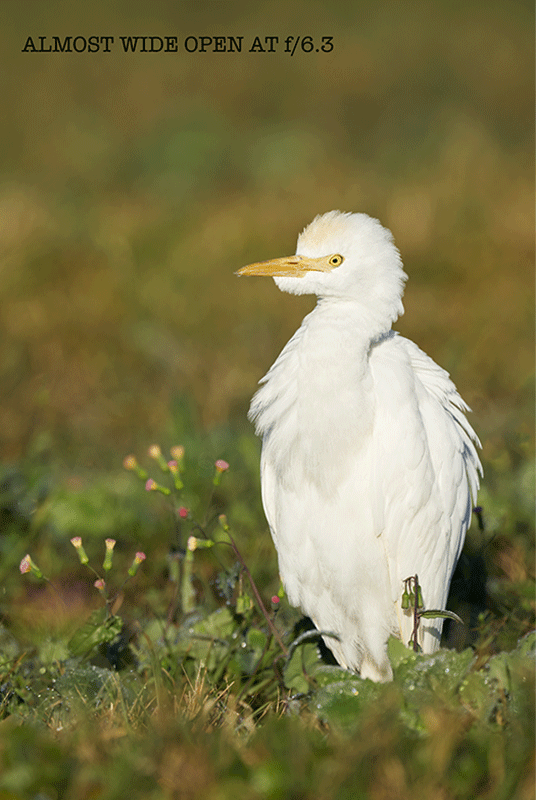
|
Doubt Me?
Sometimes it is difficult to see differences when scrolling. That’s why the man in charge created animated GIFs …
While the flowers are slightly sharper, I do not like the fact that detail in the background was increased by stopping down. I far prefer the smoother background in the image created at f/6.3. Which background do you like best, the f/6.3 background or the f/10 background? Why?
|
|
|
This image was also and obviously created 18 January 2021 while working from my SUV in the North Field at Indian Lake Estates. Again, I used the Induro GIT 404L/Levered-Clamp FlexShooter Pro-mounted Sony FE 600mm f/4 GM OSS lens and the blazingly fast AF King, the Sony Alpha a9 II Mirrorless Digital Camera Body. ISO 400. Exposure determined via Zebras with ISO on the large rear dial on the back of the camera: 1/640 sec. at f/10 (stopped down 2 2/3 stops!) in Manual mode. AWB at 9:35am on a cloudy day. Tracking Expand Flexible Spot AF-C was active at the moment of exposure and performed to perfection. Click on the image to see a larger version. Image #3: Cattle Egret and tasselflower blossoms (horizontal at 600mm) |
Removing the TC
A High Level Depth of Field Question
Noting the nice flowers to our right of the subject, I removed the 1.4X TC and rotated the lens in the tripod collar to get back to horizontal. For the image to work, I needed the bird to look to its left (our right). It did! Again, 1/640 at f/10 was still the perfect exposure.
The detail in the background was brought up even more than in Image #2. Why?
In retrospect, I wish that I had created Image #3 at f/4 (instead of at f/10). Had I done that, what would the equivalent shutter speed have been? In what way would the background have been improved?
Typos
In all blog posts and Bulletins, feel free to e-mail or to leave a comment regarding any typos or errors.


